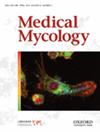2019冠状病毒病对重症监护病人血培养念珠菌抗真菌消耗和耐药性的影响
IF 2.3
3区 医学
Q3 INFECTIOUS DISEASES
引用次数: 0
摘要
重症监护病房的COVID-19危重患者中念珠菌的发病率增加。本研究旨在探讨COVID-19大流行对血液感染中抗真菌药物用量和念珠菌种类分布的影响。我们观察到,2021年非白色念珠菌病例显著增加(p = 0.005),与氟康唑耐药率升高(p = 0.002)和棘白菌素最低抑制浓度升高(p = 0.012)相吻合。值得注意的是,伏立康唑的使用和MIC水平的增加与白色念珠菌和非白色念珠菌种类均呈正相关。这项研究强调了在COVID-19大流行期间明智使用抗真菌药物的重要性。本文章由计算机程序翻译,如有差异,请以英文原文为准。
The impact of the COVID-19 on the antifungal consumption and antifungal resistance in Candida species isolated from the blood cultures of critically ill patients in intensive care units.
Incidence of Candida species increased in critically ill COVID-19 patients in intensive care units. This study aimed to investigate the impact of the COVID-19 pandemic on antifungal consumption and Candida species distribution in bloodstream infections. We observed that a significant increase in non-albicansCandida species cases (P = .005) in 2021 coincided with higher rates of fluconazole resistance (P = .002) and increased minimum inhibitory concentrations for echinocandins (P = .012). Notably, voriconazole consumption and increased MIC levels positively correlated with both Candida albicans and non-albicansCandida species. This study underscores the importance of judicious antifungal use during the COVID-19 pandemic.
求助全文
通过发布文献求助,成功后即可免费获取论文全文。
去求助
来源期刊

Medical mycology
医学-兽医学
CiteScore
5.70
自引率
3.40%
发文量
632
审稿时长
12 months
期刊介绍:
Medical Mycology is a peer-reviewed international journal that focuses on original and innovative basic and applied studies, as well as learned reviews on all aspects of medical, veterinary and environmental mycology as related to disease. The objective is to present the highest quality scientific reports from throughout the world on divergent topics. These topics include the phylogeny of fungal pathogens, epidemiology and public health mycology themes, new approaches in the diagnosis and treatment of mycoses including clinical trials and guidelines, pharmacology and antifungal susceptibilities, changes in taxonomy, description of new or unusual fungi associated with human or animal disease, immunology of fungal infections, vaccinology for prevention of fungal infections, pathogenesis and virulence, and the molecular biology of pathogenic fungi in vitro and in vivo, including genomics, transcriptomics, metabolomics, and proteomics. Case reports are no longer accepted. In addition, studies of natural products showing inhibitory activity against pathogenic fungi are not accepted without chemical characterization and identification of the compounds responsible for the inhibitory activity.
 求助内容:
求助内容: 应助结果提醒方式:
应助结果提醒方式:


